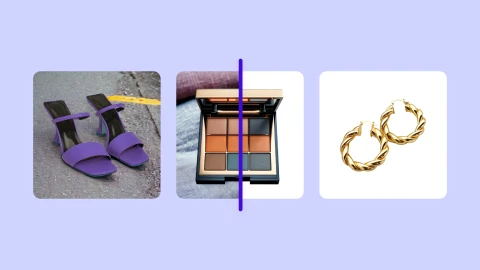How to sell your products on Poshmark


Want to turn closet cleanouts into extra cash or even a full-blown resale business? Poshmark makes it possible. But with millions of listings on the platform, simply uploading a product photo isn’t enough to make a sale. You need standout visuals, smart pricing, and a polished shop that builds buyer trust.
In this guide, we’ll walk you through everything you need to know to start selling on Poshmark—from setting up your profile to using AI tools to create pro-quality product photos in seconds. Read on and learn how to attract more buyers and boost your sales.
Table of contents:
What is Poshmark?
Poshmark is a leading social commerce platform where millions of users buy and sell fashion, home decor, beauty products, and more.
With over 100 million community members across the U.S., Canada, Australia, and India and 200 million items for sale, it’s one of the largest online resale marketplaces.
Designed for both casual sellers and full-time resellers, Poshmark makes selling easy with features like virtual Posh Parties, a built-in shipping system, and social sharing tools that boost visibility.
Sellers can list items in seconds, engage with buyers, and grow a side hustle or full-fledged business. Whether you’re decluttering your closet or running an online boutique, Poshmark turns secondhand selling into a thriving social experience.

How to start selling on Poshmark
Getting started on Poshmark is quick and easy, making it an ideal platform for both casual sellers and serious e-commerce entrepreneurs.
Follow these steps to set up your shop and start making sales.
Step 1: Create your Poshmark account
Before you can start listing products, you’ll need to set up a Poshmark account and personalize your seller profile. A well-optimized profile helps build trust with buyers and makes your shop more discoverable.

Follow these steps to get started:
Download the Poshmark app or visit Poshmark.com to sign up for a free account.
Choose a username that reflects your brand or personal style.
Customize your profile to establish credibility:
Upload a clear, professional profile picture—a well-lit headshot or a logo for boutique sellers makes your shop look polished.
Write a compelling bio that highlights what you sell, who you are, and welcomes shoppers in a friendly and engaging tone.
Link to your social media or other selling platforms to build credibility and attract repeat customers.
Set up your payment details to receive funds from sales.
Engage with the community by following other sellers, sharing listings, and responding to inquiries quickly to build your presence.
Once your account is ready, you’re ready to start listing items and optimizing your shop for visibility and engagement. Here’s how.
Step 2: List your products for sale
The key to making sales on Poshmark is presenting your products in a way that builds buyer confidence and encourages quick purchases.
This means using high-quality images, detailed descriptions, and competitive pricing. Let’s walk through best practices for each.
Take high-quality product photos
Great product photos are essential on Poshmark. Listings with clear, well-lit images stand out in search results, attract more buyers, and build trust. Since Poshmark is a visual marketplace, the goal is to create professional, eye-catching images that make your products shine.
To capture high-quality product photos that make your products stand out, be sure to:
Use natural lighting or a ring light to avoid harsh shadows and color distortion.
Choose a clean, distraction-free background like white or neutral background to ensure that products pop. Bonus: this also improves visibility in Google Shopping ads.
Showcase multiple angles and close-ups. Buyers want to see details like fabric texture, logos, and any imperfections before making a purchase. Offer multiple product photos, from multiple angles, that showcase all of the details that your buyers will care about.
Read more: Tips for product photography backgrounds (2025)
Edit and enhance your product photos with AI
To help with scaling this process, we recommend using an AI photo editing tool like Photoroom to repurpose existing product photos, and edit and enhance ones that don’t quite hit the mark.

Here are some tools that will help:
AI Background Remover. Automatically removes cluttered or distracting backgrounds, creating a clean, studio-quality look.
AI Backgrounds. Generate realistic backgrounds that match your product style, helping create engaging, on-brand visuals.
Instant Shadows. Adds realistic, studio-quality shadows to make product images look more three-dimensional.
AI Retouch. Seamlessly removes unwanted objects or distractions from your photos, keeping the focus on your product.
AI Upscale. Enhances image quality, making low-resolution photos sharper and more professional.
Batch Mode. Save time by applying edits to multiple product photos at once, ideal for sellers with high inventory.
Using these tools ensures your listings look polished, and offers greater flexibility for how you repurpose and reuse your existing product photos. This ultimately helps you increase engagement, and helps drive more sales on Poshmark.
Keep reading: Best AI product photography tips to win customers in 2025
Write a compelling product description
A well-written description helps buyers understand what they’re purchasing and reduces the chances of returns.
Include key details such as:
Brand. Name the designer or brand (for example, "Nike Air Force 1 Sneakers").
Size and fit. Provide exact measurements, especially for clothing, since sizing can vary.
Condition. Be transparent about wear and tear. Mention any flaws, even minor ones, to build trust.
Style and features. Describe the fabric, color, cut, and unique design details.
Keywords. Use relevant terms buyers might search for, like "boho maxi dress" or "leather crossbody bag."
Set a competitive price
Pricing correctly can make the difference between a quick sale and an item sitting in your shop for weeks. Here are a few best practices:
Check similar listings on Poshmark to gauge pricing trends.
Consider retail value and condition. If an item is brand new with tags, it can be priced higher than a gently used piece.
Use Poshmark’s offer feature to engage potential buyers and encourage negotiation.
Bundle discounts can attract shoppers who want to purchase multiple items from your closet.
Tip: Poshmark offers advanced filtering and sorting capabilities on their shopping pages. Use these to find similar items to what you’re listing. Note the category, sub-category, and prices for similar products. You can also use this to look at how your competition is positioning their products, and find ways to differentiate your listing.

A polished listing with professional-quality images, a clear description, and fair pricing will increase your chances of making a sale quickly. Once your items are listed, it’s time to start engaging with the Poshmark community to drive traffic to your shop.
Step 3: Make the sale and ship your product
Once a buyer purchases your item, Poshmark makes the shipping process simple by providing a pre-paid, pre-addressed shipping label.
Follow these steps to complete and ship your sale item.
Check your email for the sale confirmation. This will include the shipping label and buyer details.
Package your item securely following requirements for your country’s primary shipping carriers.
Attach the shipping label and drop the package off at a nearby shipping location (like USPS or Canada Post), schedule a free pickup, or use Poshmark’s QR code shipping option at the post office.
Track the shipment through the Poshmark app and wait for buyer acceptance. Once confirmed, funds are released to your Poshmark account.
This process makes it easier (and safer) to sell and ship items to your customers. Timely shipping and secure packaging are critical to building buyer trust and attracting repeat customers.
Tips for selling on Poshmark
To maximize sales and stand out on Poshmark, you need smart selling strategies. Here are five tips to help you sell better in this competitive marketplace.
Bundle discounts. Encourage larger purchases by offering bundle deals. Buyers can combine multiple items, and you can provide a discount to increase your average order value.
Run promotions. Use Poshmark’s "Offer to Likers" feature to send exclusive discounts to shoppers who have liked your listings. Limited-time price drops can also help drive urgency.
Promote on social media. Share your Poshmark listings on Instagram, Pinterest, and Facebook to reach a wider audience. High-quality images edited with Photoroom tools make your posts more engaging, and more likely to attract buyers.
Analyze trends. Keep track of best-selling items and adjust your inventory accordingly. Research trending styles, brands, and seasonal demand to list in-demand products.
Engage with the Poshmark community. Actively share your own listings and those of other sellers to gain visibility in search results. Following, commenting, and responding quickly to buyer inquiries also help build trust.
Using these strategies consistently will help you boost sales, grow your customer base, and create a sustainable resale business on Poshmark.
Improve your Poshmark listings with Photoroom AI
High-quality visuals don’t just make your listings look better—they help you sell faster and build credibility. Photoroom’s AI-powered tools streamline photo editing, allowing you to remove backgrounds, enhance image quality, and create polished, professional listings in seconds.
Try Photoroom today on iOS, Android, or Photoroom Web to start optimizing your Poshmark store.


















